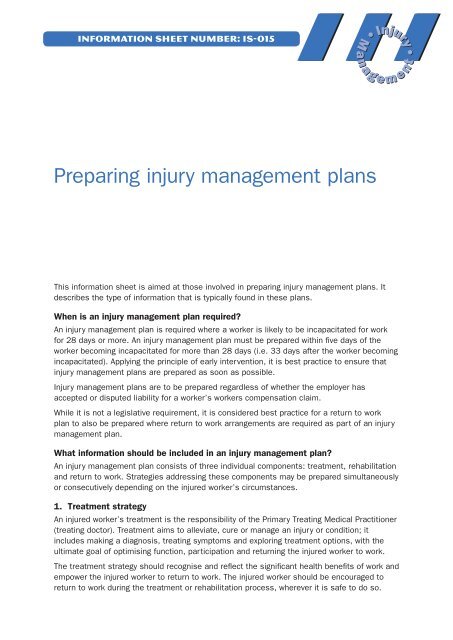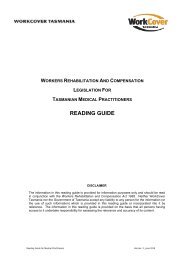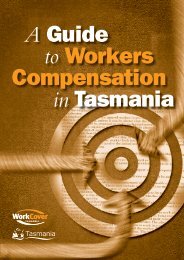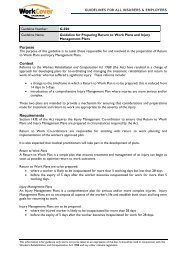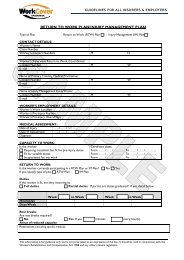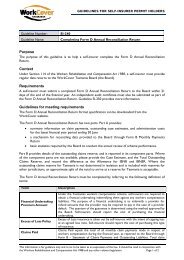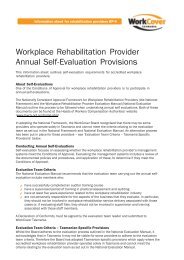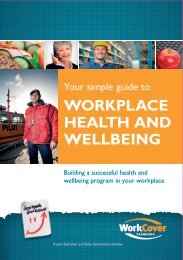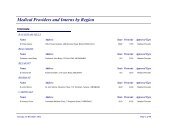Preparing injury management plans - WorkCover Tasmania
Preparing injury management plans - WorkCover Tasmania
Preparing injury management plans - WorkCover Tasmania
You also want an ePaper? Increase the reach of your titles
YUMPU automatically turns print PDFs into web optimized ePapers that Google loves.
Information sheet Number: IS-015<strong>Preparing</strong> <strong>injury</strong> <strong>management</strong> <strong>plans</strong>This information sheet is aimed at those involved in preparing <strong>injury</strong> <strong>management</strong> <strong>plans</strong>. Itdescribes the type of information that is typically found in these <strong>plans</strong>.When is an <strong>injury</strong> <strong>management</strong> plan required?An <strong>injury</strong> <strong>management</strong> plan is required where a worker is likely to be incapacitated for workfor 28 days or more. An <strong>injury</strong> <strong>management</strong> plan must be prepared within five days of theworker becoming incapacitated for more than 28 days (i.e. 33 days after the worker becomingincapacitated). Applying the principle of early intervention, it is best practice to ensure that<strong>injury</strong> <strong>management</strong> <strong>plans</strong> are prepared as soon as possible.Injury <strong>management</strong> <strong>plans</strong> are to be prepared regardless of whether the employer hasaccepted or disputed liability for a worker’s workers compensation claim.While it is not a legislative requirement, it is considered best practice for a return to workplan to also be prepared where return to work arrangements are required as part of an <strong>injury</strong><strong>management</strong> plan.What information should be included in an <strong>injury</strong> <strong>management</strong> plan?An <strong>injury</strong> <strong>management</strong> plan consists of three individual components: treatment, rehabilitationand return to work. Strategies addressing these components may be prepared simultaneouslyor consecutively depending on the injured worker’s circumstances.1. Treatment strategyAn injured worker’s treatment is the responsibility of the Primary Treating Medical Practitioner(treating doctor). Treatment aims to alleviate, cure or manage an <strong>injury</strong> or condition; itincludes making a diagnosis, treating symptoms and exploring treatment options, with theultimate goal of optimising function, participation and returning the injured worker to work.The treatment strategy should recognise and reflect the significant health benefits of work andempower the injured worker to return to work. The injured worker should be encouraged toreturn to work during the treatment or rehabilitation process, wherever it is safe to do so.
AAPossible return to work restrictions or accommodationsAAReasons for failure to recoverAALength of disability and factors influencing durationTreatment outcome measuresDetails of how the effectiveness of any treatment will be measured. Defining treatmentoutcome measures helps evaluate the worker’s progress and recovery and helps determineif the treatment for the <strong>injury</strong> or condition has been successful, is reasonable and necessary,and whether it should continue. It is also empowering for an injured worker to be able tomonitor the progress of their recovery.You will need to contact the treating doctor to discuss appropriate outcome measures, whichwill vary depending on individual circumstances and the nature of the <strong>injury</strong> or condition.As a guide, treatment outcome measures should be:AAmeasurably beneficial to the injured worker and relate to treatment goalsAAidentified and developed collaboratively between the treating doctor and the injuredworkerAAspecific, reliable, valid and sensitive to change; andAAas best practice, adhere to any relevant standardised measures (such as the MDGuidelines) and address the relevant components of the World Health OrganisationInternational Classification of Functioning, Disability and Health.For example, a treatment outcome measure for an upper limb <strong>injury</strong> may be an improvementin the rating of an injured worker’s perception of pain over time. Those involved in the<strong>management</strong> of the worker’s <strong>injury</strong> are encouraged to refer to the MD Guidelines for expectedtreatment outcomes. For example, when treating Carpal Tunnel Syndrome via surgery, thepatient is expected to be permanently relieved of symptoms, however, residual numbness,pain or weakness can be expected in some cases.MDGuidelines also provides a predictive model for the expected duration of a worker’s <strong>injury</strong>or condition. Users can input specific information about the nature of the worker’s <strong>injury</strong>/condition and other details, such as age, gender, job class or co-existing medical conditionsand MDGuidelines will predict the amount of lost time for the given scenario. This informationcan then be used as a guide to establishing and monitoring progress.2. Rehabilitation strategyRehabilitation has a broader scope than treatment and focuses on restoring or improvingan injured worker’s physical and mental capabilities that may have been lost due to their<strong>injury</strong> or condition. Various allied health professionals may be involved in an injured worker’srehabilitation, such as physiotherapists or occupational therapists.An employer may also choose to engage a Workplace Rehabilitation Provider to assistthe injured worker return to work and develop the rehabilitation strategy. A WorkplaceRehabilitation Provider helps injured worker’s return to work by providing expert advice andservices in consultation with employers, insurers, treating doctors and other providers, andthat are tailored to their specific circumstances. A Workplace Rehabilitation Provider identifiesand addresses the critical physical, psychological, social, environmental and organisationalrisk factors which may have an impact on an injured worker’s ability to successfully return towork.The following information sets out what may be included in a rehabilitation strategy.
Rehabilitation goalsThis section should set out the goals of rehabilitation. These goals describe the intendedresults of rehabilitation undertaken to help the injured worker return to their pre-<strong>injury</strong>employment. Setting goals also allows the effectiveness of the rehabilitation process to bemonitored.Rehabilitation goals should:AAhelp the injured worker return to their pre-<strong>injury</strong> employment and compensate for anyloss of physical or mental capabilities caused by the <strong>injury</strong> or condition.AAbe SMART, as for treatment goals. For example, a ‘SMART’ rehabilitation goal for aninjured worker with mobility issues could be to walk 1km in 30 minutes by the end of 3months.AAminimise the risk of re-<strong>injury</strong> and <strong>injury</strong> to others in the workplaceAAtake into account the severity of the <strong>injury</strong> or condition. Suitable goals for less severeinjuries may be a durable return to work, while for more severe injuries a suitablerehabilitation goal may focus more on developing self-<strong>management</strong> strategies in order toreturn to a functioning lifestyle (i.e. building resilience and tolerance).An example of a rehabilitation goal for physiotherapy related to a knee <strong>injury</strong> could be:AAimprove range of motion in left knee by 10 degreesAAregain a normal walking (gait) patternRehabilitation goals will usually be set by allied health professionals involved in the recoveryof the injured worker, for example a physiotherapist, or by the Workplace RehabilitationProvider. You may need to contact them to confirm or discuss appropriate rehabilitation goals.Rehabilitation arrangementsDetail any current or planned rehabilitation arrangements, including the name of therehabilitation provider and type of service provided. Remember that the injured worker doesnot necessarily need to have completed treatment for rehabilitation to begin (or at leastplanned for).Rehabilitation arrangements could include activities such as physiotherapy, speech therapy oroccupational therapy etc. Be specific about rehabilitation arrangements; for example, outlinethe number and frequency of rehabilitation sessions over the duration of the plan (e.g. twophysiotherapy sessions a week for a month).Remember that returning to some form of work should almost always be considered as partof the rehabilitation process (this is considered as part of the return to work strategy, seeitem 2 below).Rehabilitation arrangements will need to be discussed with the injured worker’s health andrehabilitation providers.
Barriers torecoverySelf<strong>management</strong>strategiesCommunicationOtherassistanceReviewContact detailsAgreement tostrategySupplementaryinformationDetail any identified barriers to recovery including workeral, social,behavioural, occupational and environmental. Barriers to recovery mayinclude, for example, the fear of re-<strong>injury</strong> or the continued certificationof an injured worker as totally unfit for work despite physical progressbeing made.Strategies for addressing overcoming barriers to recovery shouldalso be noted. It is possible that barriers identified may not haveimmediate solutions and that mechanisms to address these arelikely to extend beyond what can be addressed by the WorkplaceRehabilitation Provider or Injury Management Co-ordinator within thetreatment and rehabilitation strategy.Detail any self-<strong>management</strong> strategies that the worker has beentaught and is applying. For example, training may have been providedin pain self-<strong>management</strong> and coping strategies. The treating doctorand/or Workplace Rehabilitation Provider will be able to assist indeveloping self-<strong>management</strong> strategies.Detail the names of parties that have or will be communicated withabout the injured worker’s treatment and/or rehabilitation. Include anyother communication that may need to be provided by other parties.Maintaining the worker’s privacy is critical. For example, the worker’ssupervisor will need information about restrictions on duties andrequired breaks – but they should not need medical informationrelating to the <strong>injury</strong>. For this reason, only communicate informationthat is essential to help the injured worker’s return to work.Copies of treatment and rehabilitation strategies must only be madeavailable to the primary treating medical practitioner and not theemployer.Other assistance may include the need to involve a WorkplaceRehabilitation Provider, or an independent medical examiner or anyaction that may be required by other parties such as the insurer.Plans should be continually monitored, reviewed and updated, withtimeframes for review outlined in the plan. Ongoing monitoring andreview helps support an injured worker and ensure arrangementsare consistent with their capacity. It also ensures adjustments areidentified and implemented as required.The contact details of key parties involved in the <strong>injury</strong> <strong>management</strong>process should be documented within the strategy.It is considered best practice for agreement to be sought from boththe injured worker and the primary treating medical practitioner ontreatment and rehabilitation strategies. Given the sensitive andsometimes confidential nature of information contained within thesestrategies it is not necessary for agreement to be sought from theemployer.Once an <strong>injury</strong> <strong>management</strong> plan is effective, the injured worker andemployer must take all reasonable steps to carry out what has beenagreed to in the plan.This is likely to include information on:AAroles and responsibilities of parties involved in the <strong>injury</strong><strong>management</strong> process such as the injured worker, supervisors,managers, Injury Management Co-ordinator or co-workers;AAthe process for dispute resolution;AAthe process for disclosing information.
3. Return to work strategyA return to work strategy is prepared as part of an <strong>injury</strong> <strong>management</strong> plan and essentiallyconsists of similar information to a return to work plan (required where a worker isincapacitated for greater than five days but less than 28). For more information about thetype of information that is typically found in return to work strategies, see the informationsheet ‘<strong>Preparing</strong> Return to Work Plans’.The key difference between a return to work strategy prepared as part of an <strong>injury</strong><strong>management</strong> plan and a stand-alone return to work plan is the severity of the <strong>injury</strong> the <strong>plans</strong>address. In a return to work strategy, complex and/or severe injuries will probably require thereturn to work hierarchy to be considered and outlined. Employers should attempt to apply thereturn to work hierarchy as closely to that set out below:AAsame organisation – same or modified jobAAsame organisation – new jobAAnew organisation – similar jobAAnew organisation – new jobThe aim should be for the injured worker to return to full-time work or to their pre-<strong>injury</strong> workhours wherever possible. Arrangements for retraining and/or redeployment should also beconsidered and outlined in the return to work strategy if required, for example where theinjured worker is unable to return to their pre-<strong>injury</strong> employer. It is important that the returnto work strategy recognise and reflect the significant health benefits to injured workers ofreturning to work, and empower the injured worker to return to work.Seeking agreement on the return to work strategy from other parties, such as the treatingdoctor, is also encouraged and considered best practice. The return to work strategy is to beconsented to by both the injured worker and their employer, and copies of the strategy shouldbe made available to all parties.
For more information contact<strong>WorkCover</strong> <strong>Tasmania</strong>Phone: 1300 776 572 (within <strong>Tasmania</strong>)(03) 6233-5343 (Outside Tas)Fax: (03) 6233 8338Email: workcover@justice.tas.gov.au


